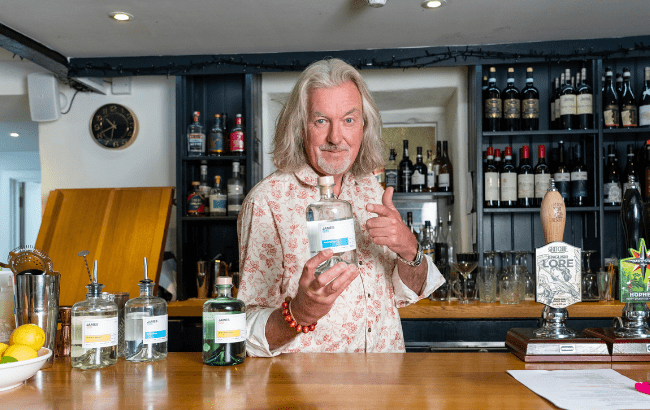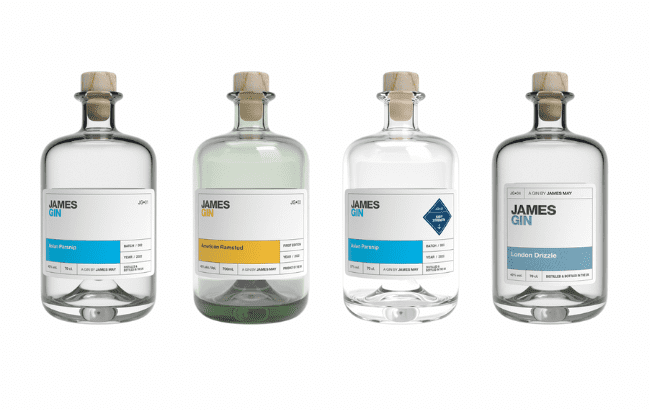SB meets… James May, James Gin
Known for his cars and his worldly TV shows, his dry, English sense of humour and now his dry gin, James May didn’t enter the spirits industry with grand goals – he just wanted to make a nice gin.

He’s since delivered on that and more, and we caught up with the presenter, journalist and now ‘drinks expert’ about his brand.
Where did the idea to make a gin stem from?
Well, our ambitions weren’t that massive. We didn’t decide to start a gin brand, we just thought we’d have a go at making gin for a bit of a laugh. We had a day at Plymouth Gin, just mucking around with a little still on a benchtop, adding botanicals and learning, and we made several samples. One of them tasted quite nice and from there I thought I’d like to have a go myself.
When I was in a bit of a fallow period with work, I went to see a distiller I’d met [Hugh Anderson of Downton Distillery] near my cottage in Wiltshire. We came up with the idea of Asian Parsnip, which he bottled and sold at gin and drink fairs he attended, and it sold out. Now we’ve got to that difficult place where we’re not a hobby anymore, but we’re not a serious commercial enterprise either. We’re in the artisanal bracket, which is a bit nauseating really, but that’s that’s how it happened – it just happened.
Do you consider yourself a big gin drinker? Why gin?
I’m not as big as Richard Hammond [May’s co-star on Top Gear and The Grand Tour], who drinks gin like I drink tea – but I do drink gin pretty regularly. It’s the spirit I drink the most. I’m a bit boring about this because I tend to have a gin and tonic. I’ve loved gin and tonics since I was a teenager.
As for gin, it’s a great spirit for mucking about and experimenting with, since it is essentially re-rectified vodka. You can come up with different flavours and different subtleties, and try different botanicals. If you made whisky you’d have to leave it for the bloody years before you can sell it (and we’re too old for that), so gin sort of selected itself.
Would you be interested in making a non-alcoholic ‘spirit’?
We talked about it and I know they’re very fashionable, but I can’t really see the point of a non-alcoholic beer or a non-alcoholic ‘gin’. I’ve tried some non-alcoholic ‘gins’ and to me they taste like cordial, which in that case, I’ll just have cordial. Why is it a trend? Has everyone suddenly become terrified of being an alcoholic?
Can’t you just have tonic water with a little bit of elderflower cordial in it? If they do taste like the real thing, then they taste like a very old gin – and that’s coming from someone who makes pretty old gin.
What’s your target demographic?
People aged, very roughly speaking I’d say, 35 or above. I don’t really get the impression that that many of ‘da kids’ are drinking gin. Or they may just not be drinking mine because it’s still quite expensive – despite our recent price drop…
If you could pick a favourite from the range?
If I had to choose, I think London Drizzle is the most radical, but Asian Parsnip is the easiest to drink. It really does work as an idea, which slightly surprised me – I thought it might taste like one of those things where you say ‘oh, that’s interesting’ and then never open it again, like the bottle of limoncello at the back of the cupboard. People do come back and keep buying it. We get quite a few repeat customers, so that’s encouraging.

What’s surprised you about the whole gin-making process?
I’m surprised by some of the things that can go into a gin – for example, oyster shells. I suppose oysters are quite distinctive, so the shell does have a bit of a bit of flavour in it, and weirdly it’s one of the few things you can put in gin that stops it from being vegan, because, you know, oysters are alive. Add to that things like wood chips, patchouli oil and beetroot (which we have in one of ours). I think you can probably put just about anything organic in the gin, but whether or not that will work is another story.
How are you faring in the on-trade?
It’s quite difficult. I did talk to Fullers once, but they have quotas for gin. They have their own beer and their affiliated wines, and then gin producers with whom they have done some sort of deal. So they won’t just take another gin on because they have existing laws here. It’s at free houses like my pub, and my local actually has it too because the landlord is allowed a certain amount of latitude with what he buys in. It’s quite difficult to break into pubs and indeed, supermarkets. Our next target is London bars, but the one we’d really love would be the miniatures on a big airline. That would be great but also it’s fiercely competitive.
Are you satisfied with how everything has played out so far?
We did it to have a world of fun, make a gin and make an entertaining little YouTube film. Then I realised it’s a bit more serious than that, and we’d actually managed to come up with something pretty good. I suppose we have to try and slightly break out of the obscure craft gin mould. We’re doing a few things at the moment. We’ve had the bottle redesigned, the labels are going to be much better quite soon, and we’ve got a new flavour coming out at some point later this year.
If it got really popular, it would then be too much for us to deal with, we’d have to pass it over and then it wouldn’t be ours anymore. I’m the world’s worst businessman. That the gin survives, I think, is almost enough reward. It’s a bit like making a slightly niche TV programme. If the people who do watch it like it, that’s more important to me than millions of people watching it and thinking ‘huh’. It’s a nice feeling that somewhere in, let’s say, Southern California, there’s a man and woman on the porch enjoying a sundowner with a gin that came out of a shed in Wiltshire. That’s what makes it worth it.
Related news
Peddlers Gin launches cocktail contest
